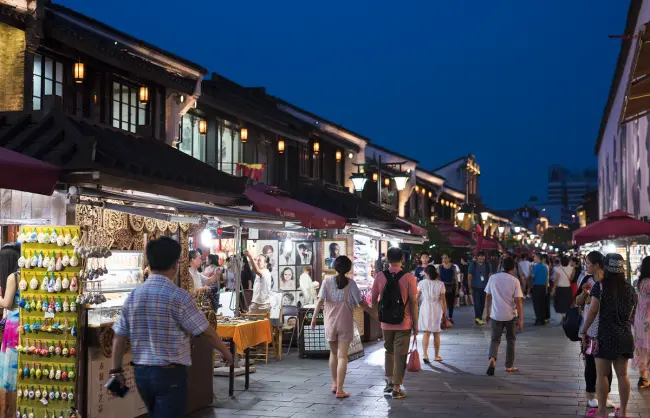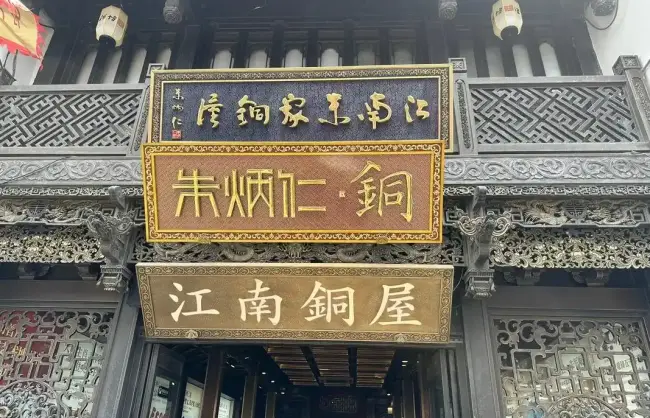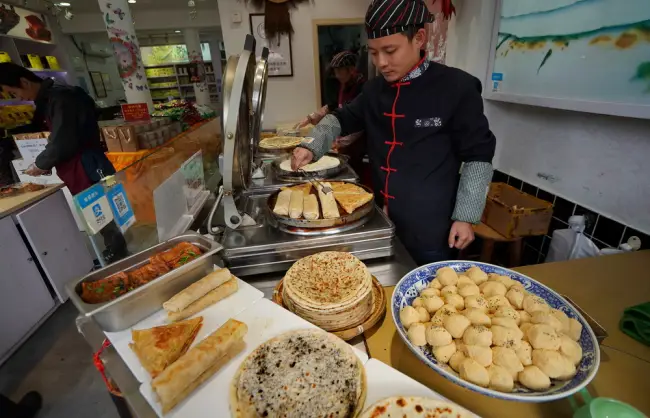Hefang Street, or 河坊街in Chinese, is in Hangzhou, the capital city of Zhejiang Province in China. It’s of great historical and cultural significance with an origin dating back to Southern Song Dynasty (1127-1279), when Hangzhou flourished as the country’s capital.
Hangzhou was the hub where commercial trade bloomed and intellectual movements took place. And Hefang Street was the city’s primary commercial channel with shops, eateries, teahouses, and entertainment.
Today, Hefang Street preserves its ancient architecture and a sense of past. Many tourists travel to Hangzhou to see this old cultural street.
Fast Facts about Hefang Street
- Location: Hefang Street, Hangzhou City, Zhejiang Province, China, 310002
- Opening hours: all day, but stores will be closed around 22:00
- Ticket price: free
- Recommended visit time: 2-3 hours
- Best time of the year: all year around, but it can be very crowded on public holidays and weekends
- Suited to: anyone interested in Hangzhou’s culture, history, food

The History of Hefang Street
Hangzhou served as the capital during the Southern Song Dynasty (1131–1162), and the royal family, officials, and nobles were erected in the Later Generations Street, Qingbo Gate neighbourhood of Hangzhou.Hangzhou served as the capital during the Southern Song Dynasty (1131–1162), and the royal family mansions and officials were erected in the Later Generations Street, Qingbo Gate neighbourhood of Hangzhou. Additionally, there were a lot of people burning incense at the Wushan temple, which made Hefang street merchants quite successful. Zhang Jun, the king of Qinghe County, also resided at Qinghefang, the centre section of Hefang Street.
At the end of the Qing Dynasty and the beginning of the Ming Dynasty, the famous “four big shops” in Hefang Street were Kong Fengchun Fragrant Powder shop, Mi Da Chang Hanyan, Bandung Ham Shop and Zhang Yunsheng Hat Village. The name suggests that men and women of all ages were shopping to sell items on Hefang Street at the time. The “five Hangzhou local specialties”—Hangzhou powder, Hangzhou scissors, Hangzhou fan, Hangzhou smoke, and Hangzhou line—are what make Hangzhou famous. Of these, Hang powder is obviously the previously mentioned Kong Fengchun powder shop, Hang scissors is Zhang Xiaoquan scissors shop, Hang fan is Wang Xingji fan village, Hang smoke, and Hang line is the special silk thread from the thriving Hangzhou silk era.
What to See and Do on Hefang Street
Indulge in Local Delicacies
There’s plenty of food to satisfy your tastebuds on Hefang Street, from traditional snacks to delightful restaurants. Try the sweet and delicate strands of dragon’s beard candy, which is made out of maltose, stinky tofu, beggar’s chicken, and the renowned West Lake vinegar fish.
Witness Traditional Crafts
As you stroll along the street, you’ll see skilled artisans at work demonstrating the artistry and craftsmanship of ancient Chinese traditions.
Witness the amazing process of paper cutting as delicate patterns come to life before your eyes. Sugar-blowing artists can transform molten sugar into intricate and vivid characters. Clay figurine makers skillfully mold clay into detailed sculptures. These talented artists carry on the rich cultural heritage of Chinese traditions.
Acquire Unique Souvenirs
Treasure hunt for some souvenirs on Hefang Street that capture the essence of Hangzhou. There are exquisite Jiangnan silk products, known for their softness and elegance. You’ll find an assortment of finely crafted tea sets with delicate and colorful patterns, beautifully designed paper fans, and traditional Chinese oiled paper umbrellas.
Explore Museums and Cultural Sites
Visit the Museum of Traditional Chinese Medicine where ancient remedies and healing practices are showcased. Hefang Street has been home to many medicine shops and families practicing Chinese medicine throughout history. Some of the shops survived till this day, such as Hu Qing Yu Tang, Yezhongde Tang, Baohe Tang, Fanghuichun Tang.

Zhu Bingren Copper Sculpture Museum
Zhu Bingren Copper Sculpture Museum is the only museum dedicated to copper sculpture in China. Occupying about 3,588 square yards (3,000 square meters), the museum is built a Ming and Qing Dynasty Jiangnan style.Except for the wall and the floor, everything else, including furniture, are all either made by copper or decorated with copper. That’s 56 ton of copper in total! Inside, you’ll see beautiful copper paintings, copper calligraphies, copper murals and copper statues.
Former residence of Hu Xueyan
You can also visit the former residence of Hu Xueyan, a well-preserved mansion once owned by a prominent Qing Dynasty businessman. The Qinghefang Ancient Well is an architectural marvel that has sustained the life of the locals for centuries.
Hu Qing Yu Chinese Pharmacy
Huqing Yutang is a medicine shop founded by Hu Xueyan in 1874 (the thirteenth year of Tongzhi of Qing Dynasty), located in Qinghefang. From the Southern Song Dynasty to the Ming and Qing dynasties, a “medicine shop” corridor was gradually formed in Hefang Street. The Chinese time-honoured brand Hu Qing Yu Chinese Pharmacy has the most ornamental value, the most humanistic traits, and the most historical style.
Fang Huichun Chinese Pharmacy
Fang Huichun Chinese Pharmacy, founded in 1649, is a time-honored Chinese medical museum with a history of more than 360 years. It was founded in Hefang Street by Fang Qingyi, a Hangzhou native from a family of traditional Chinese medicine.
Popular from the early Qing Dynasty to the late Qing Dynasty and the Republic of China, Fang Huichun Chinese Pharmacy processed different pills and powders in accordance with the legislation, followed old prescriptions, and chose medicinal materials. In October 2001, Fang Huichun Chinese Pharmacy reopened due to the reconstruction of Hangzhou Hefang Street Historical Block.
Hangzhou World Numismatic Museum
Hangzhou World Numismatic Museum, founded on June 6, 1999, is located at No. 178 Hefang Street. It is one of the first ten private museums in China. It is currently one of the member units of the Chinese National Committee of the International Numismatic and Banking Museum Committee under UNESCO, and is a museum focusing on the collection, display, display and research of domestic and foreign coins.
Enjoy the Night View and Performances
After the sun sets, Hefang Street turns into a bustling night market with countless stalls selling handicrafts and food. Come here after dinner for a night stroll along the banks of the Shengli River or Wushan Square.
Make sure you catch the renowned Impression West Lake show, a spectacular outdoor performance directed by Zhang Yimou. It takes West Lake as its stage to showcase the cultural heritage of Hangzhou through music, dance, and stunning visual effects.
Related reading: Top 10 Things to Do in Hangzhou

The suggested Traveling Route of Hengfang Street:
Willow Sea Warblers → Wushan Square → China Museum of Finance and Taxation → Hangzhou Museum → Maitreya Buddha Sculpture → Jiangnan Copper House → Huqing Yutang Museum of Traditional Chinese Medicine [Admission fee: 10 yuan] → Zhongyi Pavilion → Xinglinting → Wuliuxiang Historical District
Best Time to Visit Hefang Street
Feel free to plan your Hangzhou tour to Hefang Street any time of the year, since the climate in Hangzhou is relatively mild. But it’s important to note that during public holidays and weekends, Hefang Street sees a huge spike in visiting tourists. So be sure to check the calendar for China public holiday and avoid those times.
How to Get to Hefang Street
Metro: Take Metro Line 1 and get off at either Ding’an Road Station or Anding Road Station. These stops are only a 10-minute walk from Hefang Street.
Bus: Hefang Street is easily accessible by bus as well. Board any one of bus No.8, 60, 127, 195, 208, 216, 228, 280, 808, and Y6, and get off at Gulou Station. The station is only a 5-minute from Hefang Street.
Taxi: The easiest and quickest way to get to Hefang Street is taking a taxi. You can get a taxi from anywhere in the city. The fare largely depends on the distance and traffic conditions.
Attractions nearby Hefang Street
South Song Imperial Street is a historica street with remnants of the ancient city wall, gate, and moat from South Song Dynasty. It is only a 10-minute walk from Hefang Street.
Museum of Traditional Chinese Medicine is the only museum of its kind in China, displaying over 14,000 items related to traditional Chinese medicine. You’ll learn about various traditional therapies and treatments. It is just off Hefang Street.
Hangzhou Tours to Hefang Street









